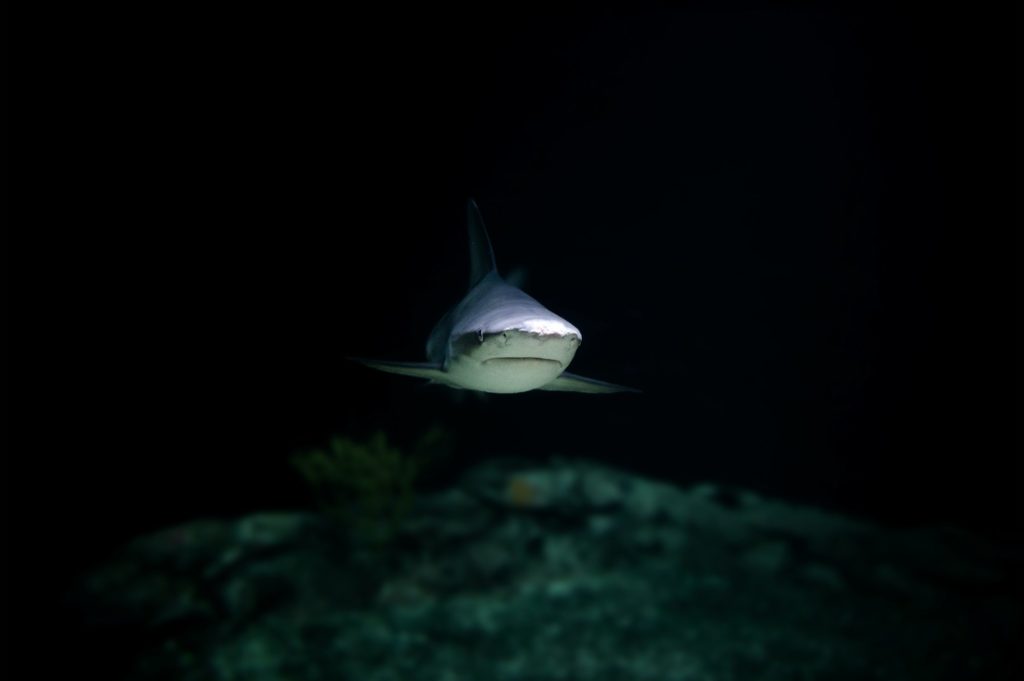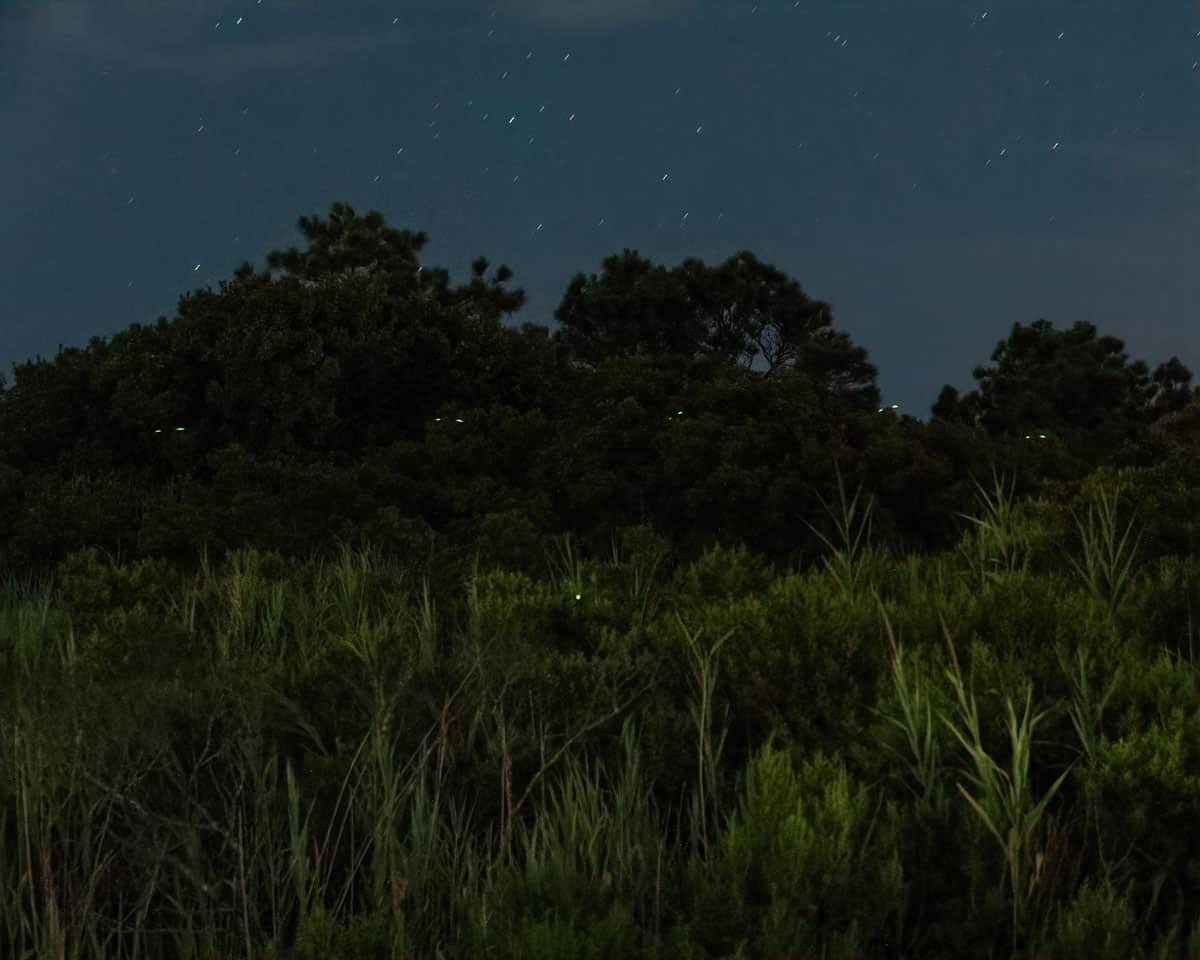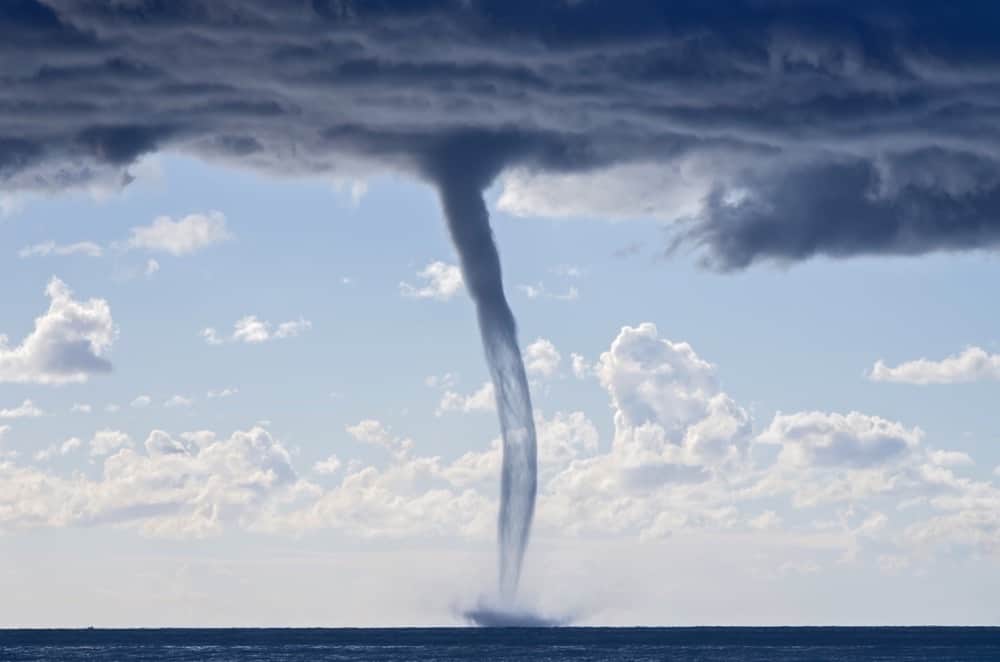Captain Mark Sampson charts the way for shark fishing and research.
There wasn’t a kid alive in the summer of 1975 who wouldn’t sprint out of the water when hearing someone shriek SHARK! Jaws remains a favorite, but the film’s genius aside, it had a negative impact on the world’s shark populations, at least for the animals’ public relations. Shark experts say the movie fomented undue fear and myths about sharks, which drove shark populations down even to the brink of extinction for some species.
Sadly, not much has changed in the decades that followed the film’s release. According to the International Union for Conservation of Nature, “More than 30 percent of the shark species and their relatives assessed by the organization are threatened with extinction.” Estimates vary as to exact numbers of sharks killed by commercial fisheries each year, but the number could exceed 200 million. And the worst of it is that most sharks are killed solely for their fins used in shark fin soup.
Moreover, biological factors such as the small number of pups produced per brood, the slow growth rates, and the time it takes for sharks to reach sexual maturity make many shark species particularly vulnerable to overfishing.
There is some encouraging news, however. Professional anglers like Captain Mark Sampson are working to reverse this disturbing trend by assisting researchers with important information on shark population status and educating people on the important role sharks play in the ocean’s ecosystem.
Based in Ocean City, Maryland, Captain Sampson is a pioneer in shark conservation, perhaps atop the field among fellow charter captains. On a gorgeous fall day last year, I tagged along with him, his first mate Tyler Hill, and his longtime client Murray Adams to experience his efforts to save sharks.
Born to Fish
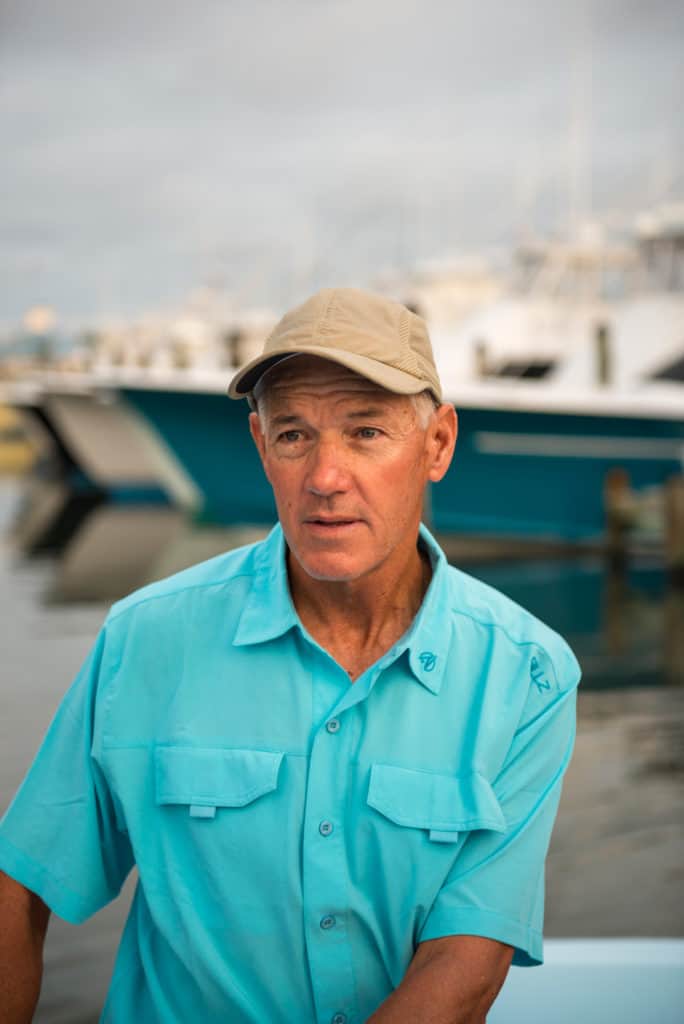
Sampson has worked in the recreational fishing industry since he was a kid—first as a dock boy and eventually as a marina manager. Since 1987 he’s made his living running charter fishing trips out of Ocean City, which is better known for white marlin fishing than sharks. In recent years, he has guided in the Florida Keys during Maryland’s offseason. He’s also published the book Modern Sharking in 2008 and he has written dozens of articles for various publications. Oh yeah, he also holds a 6th-degree black belt.
His wife Charlotte is an integral part of the operation, handling bookings, trip coordination, and countess other behind-the-scene tasks to keep things running smoothly. An Ohio native, she was introduced salt-water fishing when she moved to Maryland and married Sampson. Now, she is an accomplished saltwater angler in her own right with several world records to her credit.
Dedicated to Saving Sharks
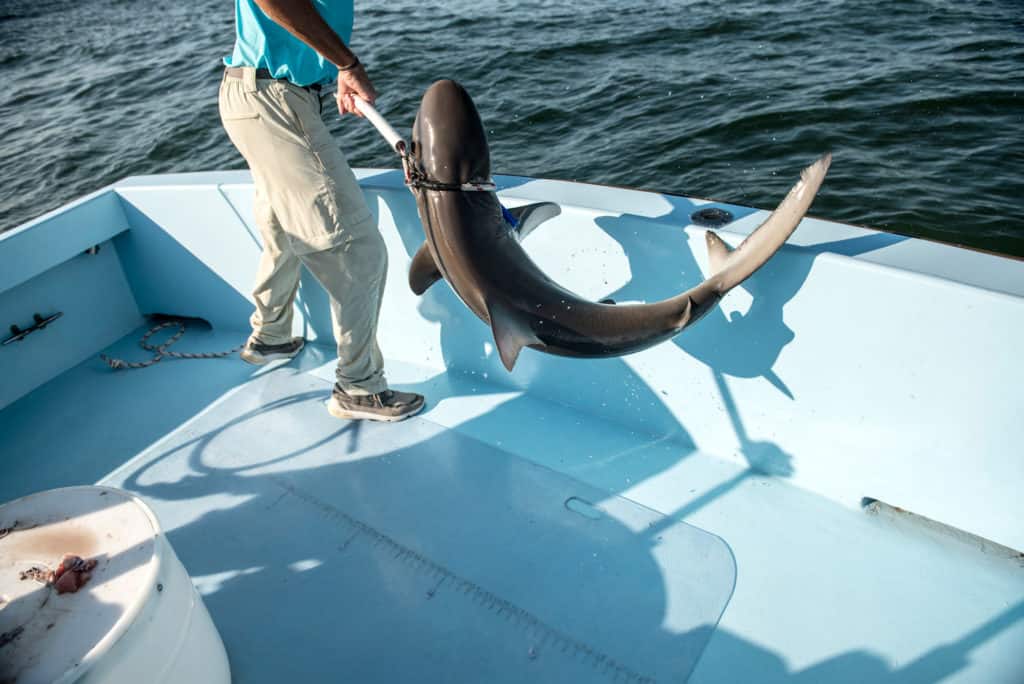
for controlling a shark
There are plenty of captains who can catch sharks. What sets Captain Mark apart is his dedication to shark conservation and his contributions to shark research. He has worked with the Guy Harvey Research Institute, Save Our Seas Shark Center at the NOVA Southeastern University Oceanographic Center, and the University of Rhode Island. He is also a volunteer for the National Aquarium Marine Animal Rescue Program and an advisor to the National Marine Fisheries Service’s Highly Migratory Species Advisory Panel.
Recently, he partnered with Maryland’s Department of Natural Resources on a hook study, and since 2013, he has run unique trips with the goal of attaching Smart Position and Temperature (SPOT) tags, which are transmitter tags fastened to shark dorsal fins.
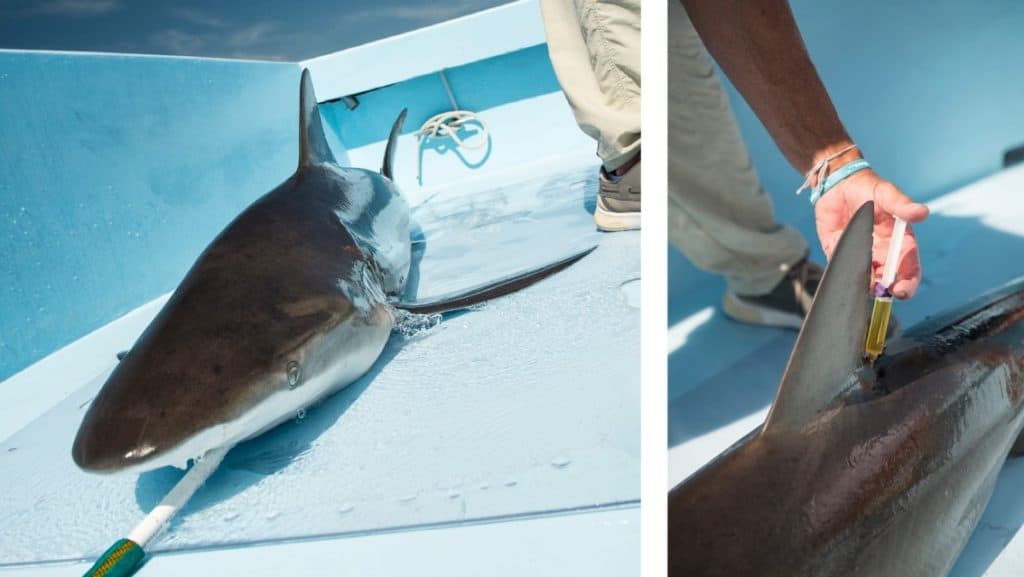
Aboard Sampson’s 40-foot boat Fish Finder, the trips blend together fishing, education, and research. These are most definitely hands-on excursions with the clients hooking the fish on conventional tackle. Once a shark is onboard, the research part kicks in. Sampson and his crew quickly subdue the fish by placing a wet towel over its eyes and then inserting a purpose-built PVC tube and hose in its mouth to deliver a steady flow of seawater through it gills. Then they measure, tag, and photograph the shark. Sampson takes a blood sample and sometimes a clip of the fin, which he will send off for DNA testing, which provides scientists stress, range, and feeding data on the fish. Sampson then administers a dose of tetracycline, which will serve as a marker for fish biologists who may have the opportunity to study the animal later. He will also note incidental information including location, sex, estimated weight, bait, hook-type, where the hook was embedded, water temperature, air temperature, and fishing gear specifics, which will go out to various research centers for their work. Then they move the shark onto a release sling, remove the seawater tube, and carefully slide the shark back into the ocean, seemingly no worse for the experience. It happens quickly, in a well-rehearsed and practiced routine.
“Because we are involved with assisting scientists in a number of different shark research projects, every shark we catch provides some measure of data to one or more studies,” he explained. “Some sharks are simply measured, released, and recorded. Some are tagged with basic recapture type tags while some are fitted with expensive satellite transmitters. Every shark landing is important and logged into our daily shark data sheet. The data is made available to shark researchers and marine managers.”
When asked to name the most pressing conservation issue facing shark populations today, Sampson answered, “Shark fin soup. Around the world, sharks are being killed in unsustainable and unimaginable numbers to feed that demand. The worst over-fishing of sharks occurs off the coasts of countries that either don’t have the necessary regulations or don’t enforce the ones they do.”
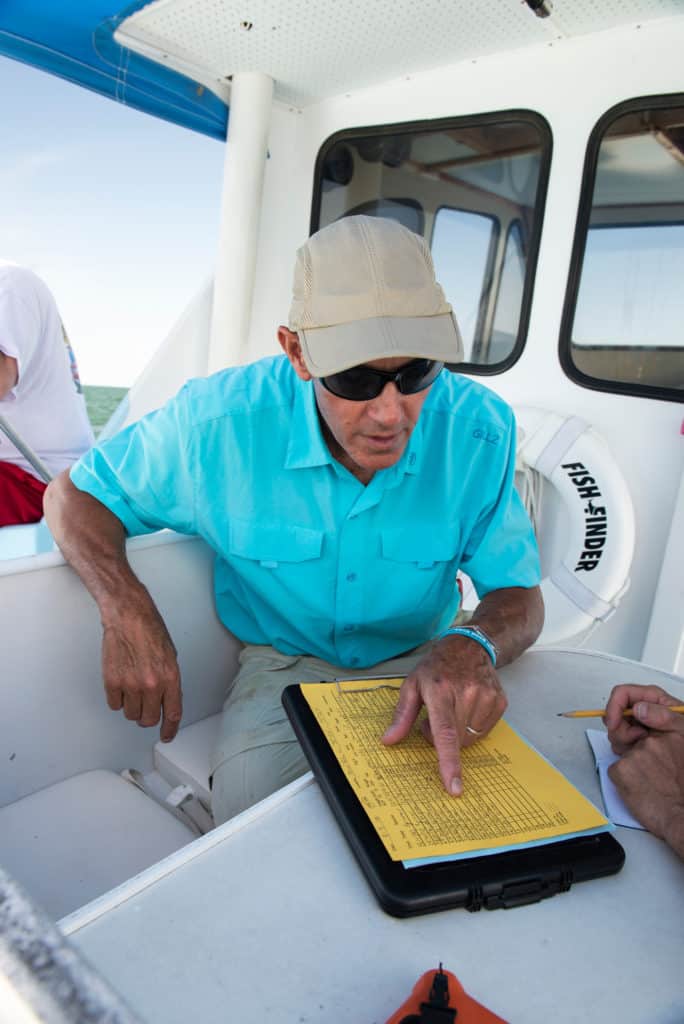
In the U.S., shark regulations are stringent. There are twenty shark species in the Mid-Atlantic zone that recreational and commercial fishermen are prohibited from keeping. The white shark (Carcharodon carcharias) of “Jaws” fame is on the list. Regulations on those who target sharks are strict and the penalties are severe. For instance, in the 12 states that have banned the sale and possession of shark fins, including Maryland fines can run from $1000 to $2000 and up to a year in jail. In New Jersey, it’s $5000 to $55,000 and year in jail. (Virginia prohibits the act of finning live sharks but not the possession or sale of fins by licensed commercial operators.) Harvesting a prohibited shark species carries the same penalties in Maryland and Virginia. “But,” Sampson says, “way too many sharks still end up dying after being unintentionally caught by those fishing for other fish. It’s crucial for shark populations and the overall health of our oceans that, in places where it is occurring, the over-fishing and incidental killing of sharks be exposed and brought under control.”
Paramount in Sampson operation is ensuring every shark destined for release is given the best chance for survival. He has developed specialized tools and techniques to safely bring sharks on board and to insure successful releases. One such invention is Sampson’s “blocker rig, “ made of material you’d find at any hardware store. Basically, it is a short length of plastic pipe mounted perpendicular on the leader above a circle hook, which “greatly reduces the chance that sharks will be hooked anywhere but in the corner of the mouth,” he explained. “We realized that, even with circle hooks, we were seeing at least five percent deep hooking in the 500-600 sharks we catch each season. We’ve spent years developing, tweaking, and testing this rig, and it has proven to be about 99-percent successful at eliminating deep hooked sharks.” He added that the invention has been adopted for use by research scientists in the Atlantic and Pacific oceans, and it was recently demonstrated by a researcher studying white sharks off of Mexico in a Discovery Channel Shark Week show.
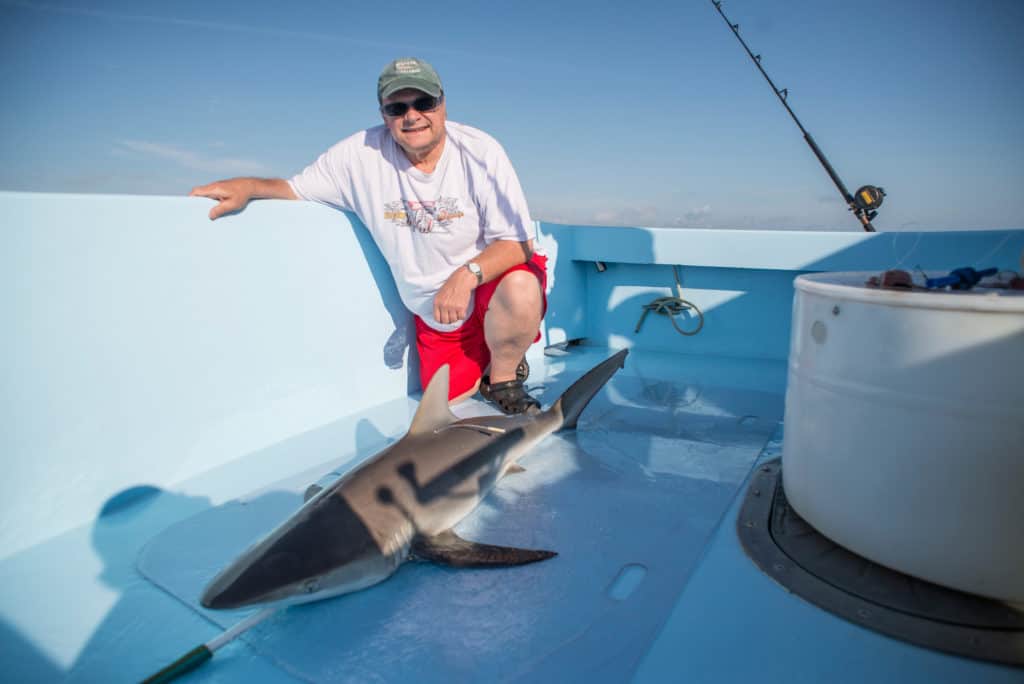
Another tool that allows working closely with sharks in a way that protects both angler and shark is the “snooter,” his homemade noose on a pole that allows him to safely lift a shark out of the water and place it on the deck. Another cool tool, closely associated with the snooter, is a customized measuring board, which measures three by six feet. What makes it unique is it has a ruler engraved in it and cut-outs for handles.
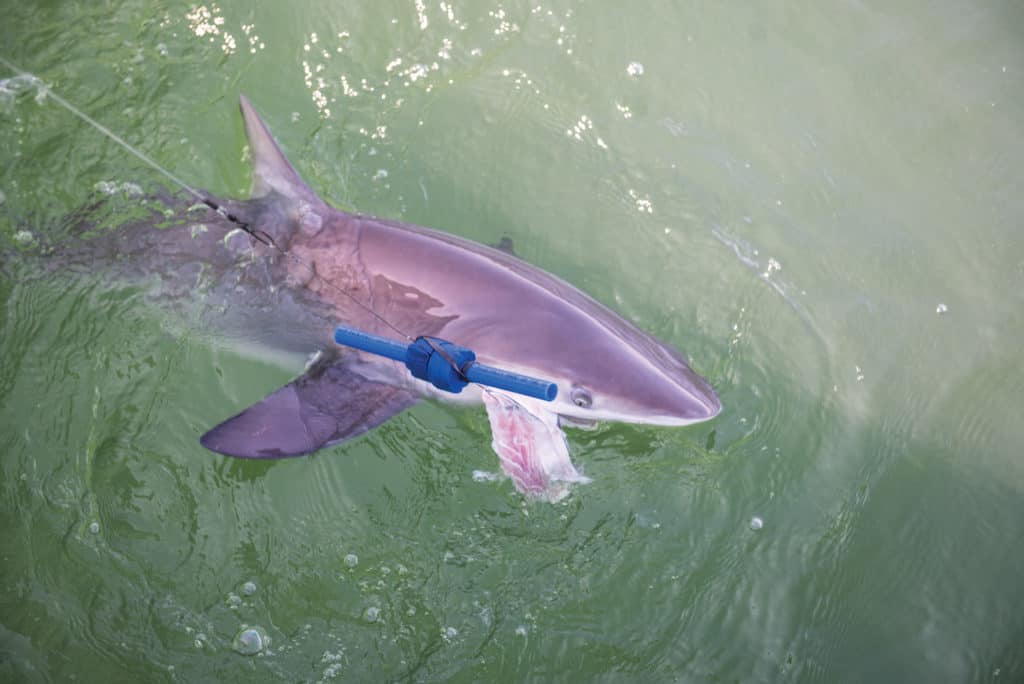
“The board allows us to measure sharks quickly and consistently, and the handles on either side allow us to use the board as a sling to lift a shark off the deck and slide it back into water,” he says. Add to that some custom made de-hooking tools, the special set-up for pumping saltwater over the shark’s gills, and a custom-made davit and sling for lifting and returning exceptionally large sharks to and from the water and you have the complete shark-whisperer set-up.
The Trip
We ran out of the Oceans City inlet for about six miles to Great Gull Shoal, a fairly popular spot for anglers. On this day, we had it all to ourselves. Hill rigged some cut bait on circle hooks and allowed them to drift back in the current. Then we talked thorough the catch-measure-release routine.
It is impressive to realize how Sampson’s clients have bought into the catch-and-release concept. It’s a credit to his efforts, leadership, and congenial personality. He is a bona fide expert without a hint of being a know-it-all, a rare and refreshing combination.
“My whole take on catch-and-release fishing is that no matter what you’re fishing for, it’s always going to be more enjoyable if you can get away from worrying about what you are or are not putting into the cooler,” he says. “Recreational fishing is fun—period! Bringing home fish for dinner should be considered as a little icing on an already great cake, and it’s always refreshing to fish with anglers who have that mind-set.”
Murray Adams, who was along for the ride that day, personifies this kind of angler. The Baltimore native is an amiable, easy-going sort who loves to fish. Now in his sixties, he’s been fishing out of Ocean City since he was a teenager and fishes with Sampson at least twice a year. In fact, he holds the boat record for the largest mako release estimated at ten feet long and 500 pounds.
On our trip, Adams broke the boredom between shark bites by manning the “pea shooter,” a light rod better suited for small pan-sized fish. He hooked and released a few weakfish and croakers, and he made it seem that all was right with the world, as long as he has a fishing rod in his hands.
Most of the sharks he landed this day were spinners, a spunky species of shark that takes its name from the spinning jumps it makes once hooked. We also teased up and caught a dusky shark of perhaps 30 pounds. Each one received the full regimen of measurement and tagging.
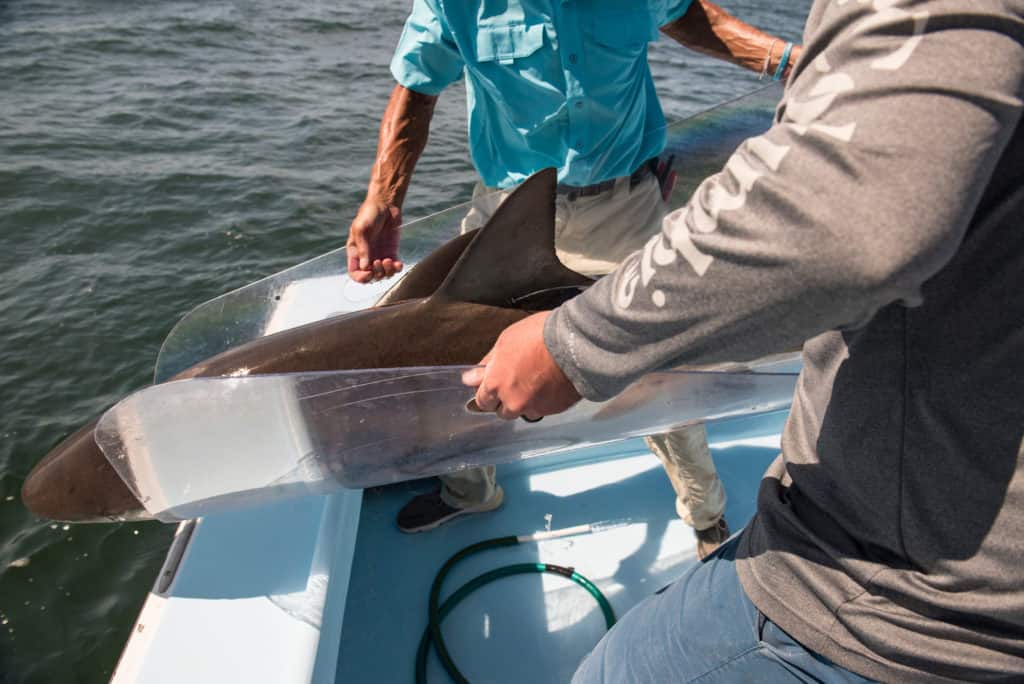
The biggest shark of the day joined us for a finale and put Adams to the test. The stout dusky shark lapped the boat twice, trying to break free of its tether by rubbing the heavy fishing line on the boat’s ground tackle. Sweat poured from Adams’ forehead as we baked under the late summer sun. In the end, Adams’s experience along with Hill’s diligence and guidance whipped the fish. In one smooth motion, Sampson lassoed and hoisted it over the gunwale where it rested upon the measuring board. After the sampling was done, it was sent back into ocean to swim and perhaps fight another day. For the record, Adams’s dusky measured 80 inches with an estimated weight of more than 100 pounds.
“If we happen to catch a shark or any other type of fish that’s good to eat, legal, and ethical to keep, and the client wants to bring it home for their own consumption, I have no problem with them doing so. But I’m not going to be the guy who encourages it,” Sampson said. “Fortunately for me, there are a lot of people out there who enjoy the heck out of having an exciting hands-on experience of fishing for, interacting with, and learning about sharks without worrying about bringing any of them back to the dock.”

